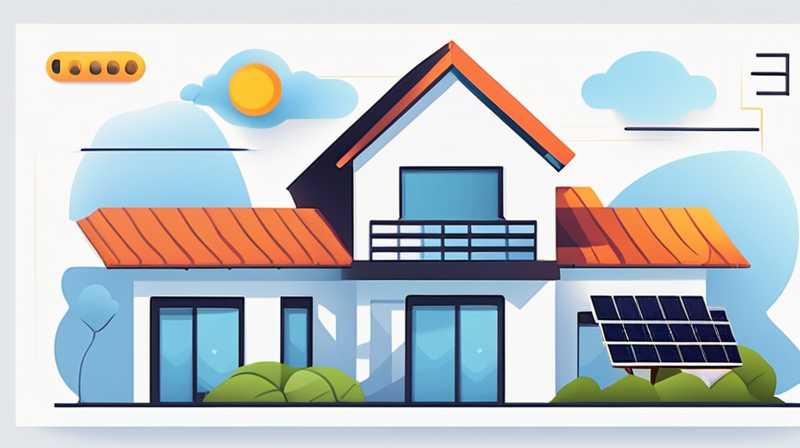
How much does a solar panel roof cost
1. The cost of a solar panel roof typically ranges from $15,000 to $30,000, depending on various factors, including system size and location.
2. The installation of solar panels often incurs significant upfront expenditures, yet these expenses can be offset by federal and state incentives, tax credits, and the reduction in utility bills over time. Many homeowners opt for financing options that allow them to spread the cost over several years.
3. The return on investment (ROI) for solar panel roofs usually ranges from 10% to 20%, influenced by energy costs, system efficiency, and local solar incentives. A detailed analysis of these factors can provide a clearer understanding of the financial implications and long-term benefits of installing solar panels.
1. INITIAL COST CONSIDERATIONS
The expense associated with solar panel roofing involves multiple layers, primarily revolving around the installation price of the solar panels themselves, along with labor charges and any necessary permitting. The size of the system, measured in kilowatts, plays a pivotal role in determining this initial cost. Homeowners must consider their energy requirements; larger households tend to need more energy and, consequently, larger solar panel systems.
In general, the average cost of solar panel installation stands between $15,000 and $30,000 for a typical residential property. This figure encompasses not only the solar panels but also inverters, mounting hardware, and labor costs. Notably, labor costs can vary significantly based on geographic location, with urban areas often commanding higher labor rates compared to rural regions. Additionally, the complexity of the installation—affecting factors such as roof angle, condition, and orientation—can further impact pricing.
2. FACTORS AFFECTING COST
When contemplating the investment in solar panel roofing, a multitude of aspects influences total costs beyond mere system size. Geographic location is paramount; for instance, areas with higher sunlight exposure often lead to more substantial savings on energy bills, thus justifying larger initial outlays. Furthermore, local regulations and incentives can either augment or diminish overall costs.
Incentives and rebates offered by local governments significantly impact the investment’s feasibility. Many states provide tax credits or rebates that can alleviate a portion of the installation costs. Moreover, federal tax credits, such as the federal solar investment tax credit (ITC), can contribute to a more budget-friendly installation. It is crucial for prospective buyers to research these incentives thoroughly, as they can alter the economic outlook for solar investment dramatically.
3. LONG-TERM FINANCIAL IMPACTS
Beyond just upfront costs, it’s essential to evaluate the long-term financial implications of solar energy investment. Reducing dependency on grid electricity allows homeowners to save substantially on energy bills over the years, thus providing a return on investment.
Typically, the ROI for solar systems ranges from 10% to 20%, influenced by energy prices and the efficiency rate of the solar panels themselves. With continually rising utility bills across the country, solar panel systems must be viewed as a hedge against future costs. Furthermore, financing options such as solar loans or leases can make the upfront investment more manageable, offering loans with competitive interest rates that can be paid down through the savings accrued on energy costs.
4. ADDITIONAL CONSIDERATIONS
In addition to financial aspects, there are several additional elements to contemplate when exploring solar panels. Maintenance and operation costs are relatively low, given solar technology’s durability and the lack of moving parts. On average, a solar system can last up to 25 years with minimal maintenance.
Moreover, the increasing popularity of solar within real estate has elevated property values. Homes equipped with solar panel roofs can see an increase in market value, appealing to eco-conscious buyers, and thus providing both short-term and long-term benefits. Evaluating these extra factors can lead to a more informed decision about whether a solar roofing investment aligns with individual financial and lifestyle goals.
FREQUENTLY ASKED QUESTIONS
HOW DO SOLAR PANELS WORK?
Solar panels function by converting sunlight into electricity through photovoltaic cells. When sunlight strikes these cells, it generates a direct current (DC) which is then converted into alternating current (AC) by an inverter for household use. The electricity produced can either be utilized immediately, stored in batteries, or sent back to the grid. This process allows homeowners to significantly reduce their reliance on traditional energy sources and can lead to substantial savings on monthly utility bills.
WHAT INCENTIVES ARE AVAILABLE FOR SOLAR PANEL INSTALLATION?
Numerous incentives exist to help lower the installation costs of solar panels. To start, the federal investment tax credit (ITC) allows homeowners to deduct a percentage of their solar installation costs from their federal taxes. Many states and local governments also offer their incentives, such as cash rebates, tax credits, and grants. Additionally, some utility companies implement net metering, enabling homeowners to sell excess electricity back to the grid, further enhancing the return on investment.
IS SOLAR PANEL MAINTENANCE REQUIRED?
While solar panels are generally low-maintenance, some upkeep is needed to ensure optimal performance. Regular cleaning is necessary to remove debris, dust, or snow that might block sunlight. Homeowners may also want to schedule periodic inspections to check for any logistical issues or system malfunctions. Most solar panels come with warranties that cover performance for 20 to 25 years, providing assurance regarding their long-term efficiency.
The investment in a solar panel roof represents a significant financial commitment that can bring about substantial savings and environmental benefits over time. Costs can vary greatly based on factors such as installation size, geographic location, and available incentives, which necessitates thorough research for potential buyers. By analyzing the long-term financial impacts, including savings on utility bills and the return on investment, customers can make better-informed decisions regarding solar panel installations. Moreover, the low maintenance requirements and added property value further solidify solar panels as an appealing option for modern homeowners. Ultimately, solar panel technology aligns economic practicality with sustainable living, offering numerous advantages that merit serious consideration for anyone looking to invest in energy-efficient home solutions.
Original article by NenPower, If reposted, please credit the source: https://nenpower.com/blog/how-much-does-a-solar-panel-roof-cost-2/


